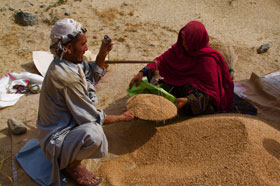Afghanistan is one of the poorest countries in the world. Since the Soviet invasion in 1979, it has been the scene of a series of conflicts that have continued for three decades.
Poverty in Afghanistan is widespread throughout rural and urban areas. The government estimates that 42 per cent of the country’s total population lives below the national poverty line. Another 20 per cent of the people live just above that line and are highly vulnerable to the risk of falling into poverty.
Afghan households tend to be large. They include numerous children and several generations that share the same dwelling. Agriculture is traditionally the major activity for a large portion of the population, but the sector has suffered from nearly 30 years of conflict, low investments and natural disasters. The average size of landholdings is small, and as a result agriculture is rarely the main source of food or income. About two thirds of rural households own some livestock, and farmers also sell their labour.
Who are Afghanistan’s rural poor people and where are they?
The incidence of poverty is more severe in rural areas. About 45 per cent of rural people and the nomadic Kuchi people are poor, as compared to 27 per cent of the urban population.
The poorest rural people include small-scale farmers and herders, landless people and women who are heads of households. There are an estimated 1 million Afghan widows. Their average age is 35, and 90 per cent of them have an average of four or more children. Without the protection of a husband, widows suffer from social exclusion in Afghanistan’s patriarchal society. Many widows have no choice but to become beggars.
Children aged five or under are the most vulnerable segment of Afghan society. As many as 50 per cent of them suffer from chronic malnutrition.
The estimated 1.5 million Kuchis are nomadic herders whose livelihood depends heavily on livestock and migration patterns. As a result of conflict and insecurity, in recent years 15 per cent of Kuchi families have been forced to settle because they have lost their livestock and migration routes. They are now among the poorest households in rural areas.
Between 2002 and 2005 there was a major inflow of refugees returning to their homes. The flow has dwindled because of increasing insecurity, limited economic opportunities and limited access to basic social services. For people who have resettled after as many as two decades of exile, economic and social reintegration is a serious challenge. And internal displacement remains a problem. There are as many as 160,000 internally displaced persons, mainly in southern Afghanistan.
Poverty varies significantly between provinces, from a poverty headcount of 10 per cent to more than 70 per cent. Poverty is most severe in the Northeast, Central Highlands and parts of the Southeast. The provinces of Daikundi, Badakhstan, Zabul and Paktika represent large pockets of poverty.
Up to 70 per cent of Afghans are food insecure, according to the UN Food and Agriculture Organization, and high food prices have recently pushed millions into high-risk food insecurity.
Why are they poor?
A basic lack of resources affects the majority of Afghans who depend on agriculture for their livelihood. There is little arable land per capita, precipitation is scarse, and climatic conditions are difficult in many parts of the country. Since 1999, recurrent droughts have severly affected the livelihoods of rural households, which had already lost many of their assets.
Despite significant improvements since 2001 in governance, social services and transport infrastructure, three decades of conflict have left most Afghans in conditions of hardship and insecurity. Much infrastructure remains to be reconstructed, and internal markets are still disrupted.
Poverty in Afghanistan is closely related to:
the high illiteracy rate in rural areas, where 90 per cent of women and 63 per cent of men are unable to read or write
*rural people’s dependance on
*livestock and agricultural activities for at least part of their income
*inadequate land ownership and access to land
*lack of irrigation infrastructure
Many rural households are poor because they have incurred heavy debts, or because they live in remote, disadvantaged areas, or because they have lost the male head of the household. Often one or more members of the households is disabled.
Source: IFAD
http://www.ruralpovertyportal.org/country/home/tags/afghanistan




